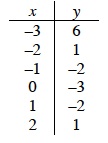x-intercept
x-y interchange
x → y table

y-intercept
| A | B | C | D | E | F | G | H | I | JKL | MN | O | P | Q | R | S | T | UV | WXYZ |
|---|---|---|---|---|---|---|---|---|---|---|---|---|---|---|---|---|---|---|
| Algebra 2 Connections Glossary | ||||||||||||||||||
x-intercept |
|
|---|---|
| A point where a graph intersects the x-axis. In two dimensions, the coordinates of the x-intercept are (x, 0). In three dimensions they are (x, 0, 0). (pp. 11, 446, 447) See “intercept.” | |
x-y interchange |
|
| The result of exchanging the x and y variables and then solving for y. The resulting equation is the inverse of the original function. (pp. 276, 283) |
|
x → y table |
|
| A table that represents pairs of related values. The input value x appears in the first row or column, and the output value, y, appears in the second. The x → y table below contains input and output pairs for the equation y = x2 − 3 . (p. 8
|
|
y-intercept |
|
| A point where a graph intersects the y-axis. In two dimensions the coordinates of the y‑intercept are (0, y). In three dimensions, the coordinates are (0, y, 0). (p. 11) See “intercept.” | |
zero factorial |
|
| Zero factorial is 1, 0! = 1 . (pp. 522, 526, 543) | |
zero power |
|
| The result of raising any number (except zero) to the zero power is 1. x0 =1 for any number x ≠ 0. (pp. 132, 148) | |
Zero Product Property |
|
| When the product of two or more factors is zero, at least one of the factors must equal zero. Used to solve equations in factored form. For example, given the equation (x − 4)(x + 5) = 0 you can see that 4 and –5 are solutions and that they are the only possible solutions because there are no other numbers that make either factor zero. (p. 23) | |
zeros of a function |
|
| The roots of a function or the values of x for which the function value y = 0. The x-intercepts of the graph of a function in the real plane are zeros. These are also called the roots of the function. A function can have complex zeros. These complex zeros cause y = 0, but they are not x-intercepts since they do not exist in the real plane. (p. 447) See “roots of a function.” | |